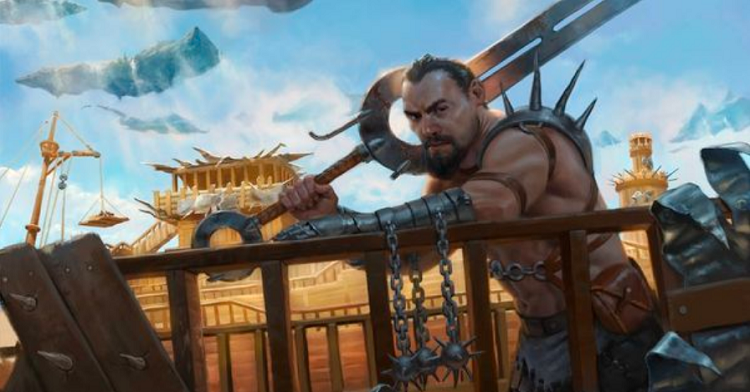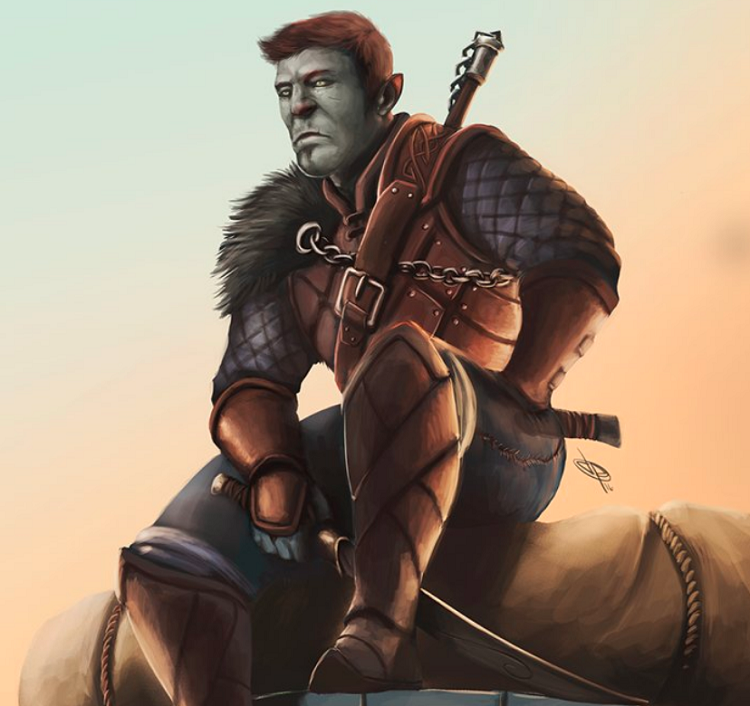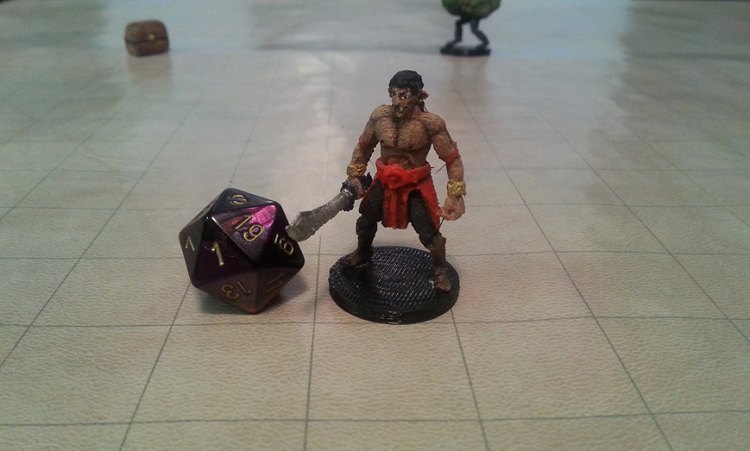Ah, Bandits. Such a staple of DnD, and for good reason. They’re fun to roleplay, easy to run as monsters, and can generate an entire adventure if PCs decide to take down the Bandit Captain.
I’ve run plenty of Bandits over the years as a Dungeon Master and, like most DnD players, encountered plenty on the road as a player too. As with any ‘monster’ NPC, I try to make my Bandits a bit more interesting for players.
A one-off encounter on the road can still be an interesting fight and can even turn into a fully-fledged adventure, so this article covers both the basic info and specific advice from my experience running Bandits in DnD games.
This Bandit 5e guide covers everything you need to know about Bandits in 5e, from essential stats and attributes to advice on how to run these scrappy villains. As always, there’s no need to make Bandits a boring, humdrum enemy, even if they are an old-school DnD ‘monster’.
Bandits in 5e: Essential Info
Bandits are a common enemy in Dungeons & Dragons that PCs will encounter on the road or in forests as they travel from place to place. They aren’t especially difficult (a 1/8 challenge rating), but they rely on numbers and have a tougher Bandit Captain with them (with a 2 challenge rating).
Pirates are essentially the Bandits of the seas, so seafaring D&D campaigns will have these instead, but the mechanics remain the same.
The most important thing to remember as a DM (and a player) about Bandits and Pirates is they have two motivations: loot and their lives.
Bandits and Dungeons & Dragons: A Mini History

Bandits are a classic fixture of DnD, thanks to their roots in medieval history. These men (usually) were often outlaws, on the run from the law, or simply marginal figures who were ‘masterless’ and so lived on the outskirts of society.
Bandits were popular figures in poems and ballads in the medieval and early renaissance periods, including ‘good’ bandits like Robin Hood. As both real and imaginary figures in the popular imagination, it’s no surprise they feature so often in traditional medieval-inspired Dungeons & Dragons.
In DnD, Bandits are usually human, always humanoid, and travel in large groups to attack unsuspecting travelers on the road and extract gold from them. They are not the smartest nor the toughest enemy, but they are scrappy and often appear in large numbers.
Typically, PCs will encounter a group of Bandits with a Bandit Captain. The Bandit Captain has their own set of stats and actions, so be sure to distinguish between them in your games.
Bandits 5e: DM’s Guide
If you’re DM’ing a DnD game, Bandits will inevitably appear as enemies at some point. They’re a good random encounter whenever PCs are traveling between locations and make excellent enemies for early level PCs who may need to take down a local Bandit Captain.
Bandit Actions
As per the Monster Manual, Bandits have two typical attack actions. Which one they take depends on whether they’re using a melee or ranged weapon.
- Melee Bandit Action: Melee weapon attack with a Scimitar:
- To hit: +3
- Reach: 5ft
- Targets: 1
- Damage: 4 (1d6 + 1) slashing damage
- Ranged Bandit Action: Ranged weapon attack with a Light Crossbow:
- To hit: +3
- Range: 80ft (normal) / 320ft. (long)
- Targets: 1
- Damage: 5 (1d8 + 1) piercing damage.
As you can see, Bandits are a pretty simple enemy to run, but they don’t have to be boring. In the below sections on Roleplaying Bandits and Bandits in Combat, I’ll expand on ways you can make these villains more interesting for your players.
Bandit Attributes
Here’s the essential info on Bandit attributes and stats provided in the Monster Manual:
- Armor Class: 12 (Leather Armour)
- Hit Points: 11 (2d8+2)
- Speed: 30ft
- Challenge: 1/8
- XP: 25
- Passive Perception: 10
- Languages: Any one (usually Common)
- Stat Block: STR – 11; DEX – 12 (+1); CON – 12 (+1); INT – 10; WIS – 10; CHA – 10
Bandit Captains
Bandit Captains are tougher than their inferiors and may have an additional motivation: infamy. While the standard Bandit only cares for loot and their life, Bandit Captains may want to make a name for themselves and their gang.
By inspiring fear on the roads, they may be able to make travelers more likely to surrender money rather than put up a fight.
Bandit Captain Actions
Bandit Captains can make either a ranged or melee multiattack. The options as given in the Monster Manual are:
Melee Bandit Captain Action: Two melee weapon attacks with a Scimitar:
- To hit: +5
- Reach: 5ft
- Targets: 1
- Damage: 6 (1d6 + 3) slashing damage
And one melee weapon attack with a Dagger:
- To hit: +5
- Reach: 5ft
- Targets: 1
- Damage: 5 (1d4 + 3) piercing damage
Ranged Bandit Action: Two ranged weapon attacks with a Dagger. Same stats as above except:
Range: 20ft (normal) / 60ft. (long)
Bandit Captain Reactions
Bandit Captains can also react with a Parry. When a melee attack made by a creature that Bandit Captain can see is made against them and would hit them, they add 2 to their AC against that attack, so long as they are holding a melee weapon.
Bandit Captain Attributes
For the tougher Bandit Captain, the Monster Manual provides the following attributes:
- Armor Class: 15 (Studded Leather Armor)
- Hit Points: 65 (10d8+20)
- Speed: 30ft
- Challenge: 2
- XP: 450
- Passive Perception: 10
- Languages: Any two (one is usually Common)
- Stat Block: STR – 15 (+2); DEX – 16 (+3); CON – 14 (+2); INT – 14 (+2); WIS – 11; CHA – 14 (+2)
Pirates and Pirate Captains
The actions and attributes of Bandits and Bandit Captains can also be applied to Pirates and Pirate Captains. The motivations for loot and, for captains, infamy, remain the same, but with the added bonus of a ship to protect and wield.
Pirates will have a more complex set of positions and ranks on their ship compared to Bandits, who may simply be a group of bandits with one captain. Some additional roles on a pirate ship to consider:
- Quartermaster: On pirate ships, the Quartermaster will often be second in command and is the one supervising and giving direct orders to the crew during attacks.
- Bosun (Boatswain): The Bosun oversees the everyday tasks of maintaining and sailing the ship.
- Navigator: Duties relating to navigation and maps go to the ship’s Navigator.
- Gunner: If your campaign has gunpowder-fuelled artillery, your pirate ships will have cannons. Your ship may have a Gunner and a Gunner’s mate to handle the artillery and yell “Fire!”.
- Surgeon: Pirate ships will have a dedicated surgeon who may have chopped off a lot of limbs in his or her time.
- Cook: Every pirate ship needs a cook, and, to take inspiration from Long John Silver, your pirate cook may be more conniving and manipulative than the captain themself.
When running Pirate NPCs in my most recent campaign, I drew a lot of inspiration from classic pirate literature, such as Treasure Island and On Stranger Tides, and the Starz TV series Black Sails.
If you’re including pirates, especially in a Sword Coast setting, I’d highly recommend checking out these books and Black Sails and robbing them blind for ideas.
Roleplaying Bandits
Bandits typically roam the roads and forests, jumping out on unsuspecting travelers. That means when your players are en route to a new location, Bandits are up there with wolves as classic monsters to deal with on the road.
Bandits are motivated by loot, but they also want to live to spend that loot. So when roleplaying Bandit NPCs, bear in mind that they won’t dive into a fight they’ll lose. Here are some tips to keep in mind when roleplaying Bandits:
- Negotiators: Rather than diving straight into a fight, Bandits may negotiate with the PCs, usually led by the Bandit Captain. In the first instance, they might demand all of the PCs’ gold before fighting. If the PCs look likelier to win a fight, they might ask for a smaller amount to avoid bloodshed on both sides, which the PCs may take if they’re already injured or en route to a battle.
- Tolls: A typical demand from a group of bandits might be to demand a toll from PCs for traveling on a specific road or crossing a bridge. Bandits might insist that they own the bridge and give PCs the option to pay the toll and cross or enter combat.
- Liars: While Bandits and Bandit Captains are not especially insightful or intelligent, they’re certainly willing to lie and attempt to manipulate PCs. Whether it’s a cold “kill them” after taking all of their victim’s money, despite promising not to, or concocting a false story or a trap on the road, never assume that a Bandit is being truthful.
- Lairs and camps: Bandits also have a base to return to, often a camp or a lair within, say, a cave or abandoned ruin. It will be off the road and out of sight, but locals in any area may know where to find it (so they can avoid it). Bandit lairs and camps will be well guarded and have lookouts but can certainly be attacked, or a Lawful group of PCs may even hand over the location to local authorities.
Bandits in Combat
Keeping in mind how many Bandits value their lives, it’s unlikely they will simply fight to the death. They will rely on their numbers and try to get the victims to surrender rather than killing them. And if things go south, will try to get out with their lives intact.
- Surround: In terms of positioning, Bandits will try to surround their enemies, ideally outnumbering them. Bandit Captains will be in the fray, but a large Bandit group might have some ranged members shooting Crossbows from up high.
- Dodge: The Monster Manual doesn’t mention any actions for Bandits other than Attack, but I use Dodge for my Bandit NPCs. If a Bandits takes a few hits or gets separated from their fellow Bandits, they will use the Dodge action to evade an enemy.
- Morale: I make good use of Morale checks when running Bandit enemies. This mechanic is optional and provided in the Dungeon Master’s Guide. If it looks likely that the PCs will defeat the Bandits, the Bandit Captain makes a Wisdom saving throw (at disadvantage if things look especially bleak), and on a fail they will command the Bandits to flee. Bandits can then use the Dash action to flee.
- Surrender: If the Bandit Captain or a small group of uncaptained Bandits are all that’s left, and escape looks difficult, they may drop their weapons and surrender, begging for their lives.
Bandit NPCs – Unique Storylines
Sure, you can use Bandits as one-off encounters on the road, but you can also incorporate them more meaningfully into your world and even create adventures around them. Here are some ideas you could use in your campaign:
The One Bandit King
Bandits in these parts have always been a problem, but not one that ever inspired local authorities to deal with them. They were a menace on the roads but mostly left travelers robbed of gold rather than robbed of their lives. But things have changed lately.
Rather than roaming in separate groups, a giant bandit camp has been set up, one so large that a small army would be needed to take it. What brought all these bandits together?
They call him the One Bandit King, a mysterious but charismatic individual who has managed to unite separate groups of bandits under one flag. These bandits have been taking over towns, murdering nobles, and now they’ve set their sights on the city.
Accidentally Undead
In search of a new hideout after the PCs rooted them out of their previous cave, this group of dastardly but not so smart bandits found what looked like a cozy abandoned temple. It even has wall torches that never go out! And these old coffins will make decent beds once the bones inside have been shifted.
Turns out moving bones in ancient temples sometimes sets off curses. What was once a goofy group of bandits that the PCs considered ‘defeated’ are now undead, more powerful, and after revenge. They’ll lure the PCs to their new haunt, kill them, and raise them again to join their gang.
The Prophetess
The PCs thought they were dealing with a standard gang of bandits until zap — a sleep spell hits them, and they wake up with their belongings gone and their foreheads painted with a strange symbol.
Asking around in local villages, they discover that these weren’t run of the mill bandits. They’re followers of a strange prophetess of a chaotic god who has granted their captains magical powers.
These bandits aren’t just motivated by loot, and they’re much freer with their own lives now they are serving a religious purpose. If the PCs want to stop them (and get their stuff back), they’ll need to root out this Prophetess first.
The Runaway Bride
The PCs are hired by a noble to retrieve his fiancee, who went missing the night before their wedding. A few days later, a ransom note was sent with a lock of her hair. But this noble has already forked out enough money on his bride’s dowry and figures it’d be cheaper and more satisfying to hire some adventurers to kill the bandits and return her.
Except when the PCs find the bandit camp, things aren’t as simple as they appeared. Not only is the bride here by choice, she’s now the Bandit Captain, and returning her to her fiancé won’t be as easy as thought.
She may try to get the PCs to join her plan of extracting money from her fiancé for a share, or she might have more sinister plans for her hometown that the PCs can’t let come to fruition.
Frequently Asked Questions
Question: Can I Play a Bandit in 5e?
Answer: Yes, you can certainly play a Bandit in 5e, although this should be done by customizing an existing class rather than using the Monster Manual attributes.
You might be a former Bandit or one on the run for his or her captain. Typical classes for Bandit PCs are Fighter or Rogue. You could homebrew a Bandit background to give yourself Proficiencies in Intimidate and Survival. =
Question: How many Bandits Should Attack Level 1 PCs?
Answer: For a medium-level encounter for level 1 PCs, I would advise one Bandit per PC plus a Bandit Captain. Use the Building Encounters guide provided in the Dungeon Master’s Guide (pp. 83-4).
Question: What Alignment are Bandits in 5e?
Answer: Bandits are usually a non-Lawful alignment, but I don’t fully agree with this. It’s very possible that a group or several groups of Bandits will abide by a Bandit Code. Pirates will certainly have rules and laws on board their ships.
Think carefully about Bandit motivations and backstories — is this just a roaming group looking for loot or are they run by a mad Bandit Captain with an evil plan?
Conclusion: Are Bandits Your Basic Bad Guys?
Bandits are about as basic as it gets when it comes to DnD ‘monsters’. They have basic actions and stats, making them easy to deal with even at low levels and very easy to run as a DM. But just because they’re your basic bad guys in DnD, it doesn’t mean they have to be boring.
By using a wider range of tactics for Bandits, like negotiating before or instead of combat and using Dodge and morale checks during combat, you can add variety to Bandit encounters.
And while their loot and their life motivation keeps things simple, there’s no reason why you can’t add a touch of world-building to even the most basic Bandit encounter.
- Best Alternatives to Dungeons & Dragons - August 23, 2023
- Wyverns 5e Guide: The Chickens of the Dragon Family - September 5, 2022
- Best DnD Dice Tray Ideas for Players and DMs - August 22, 2022






